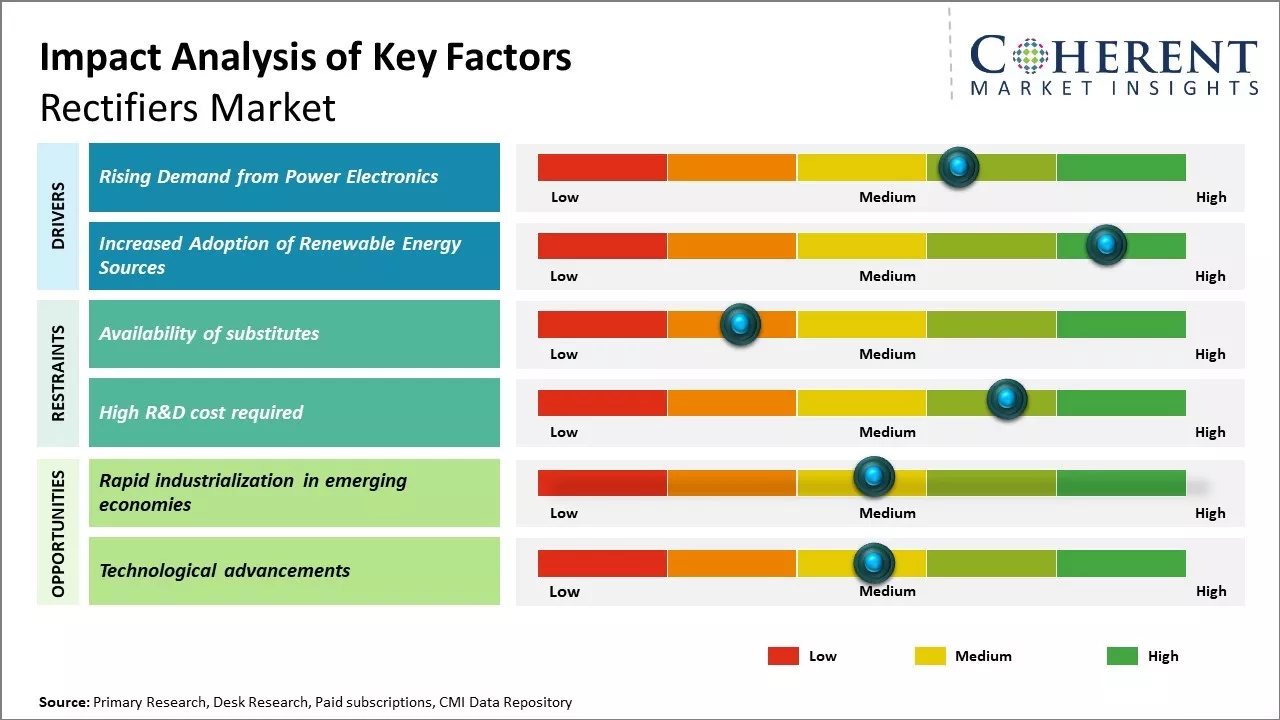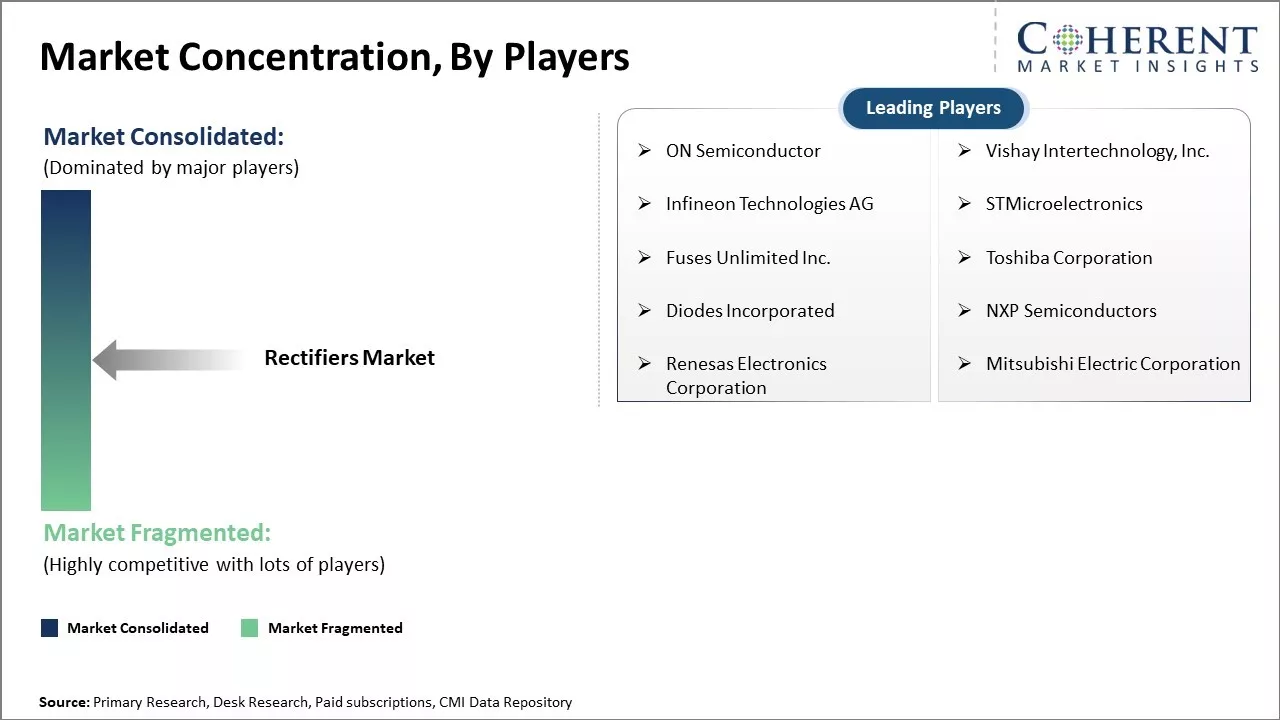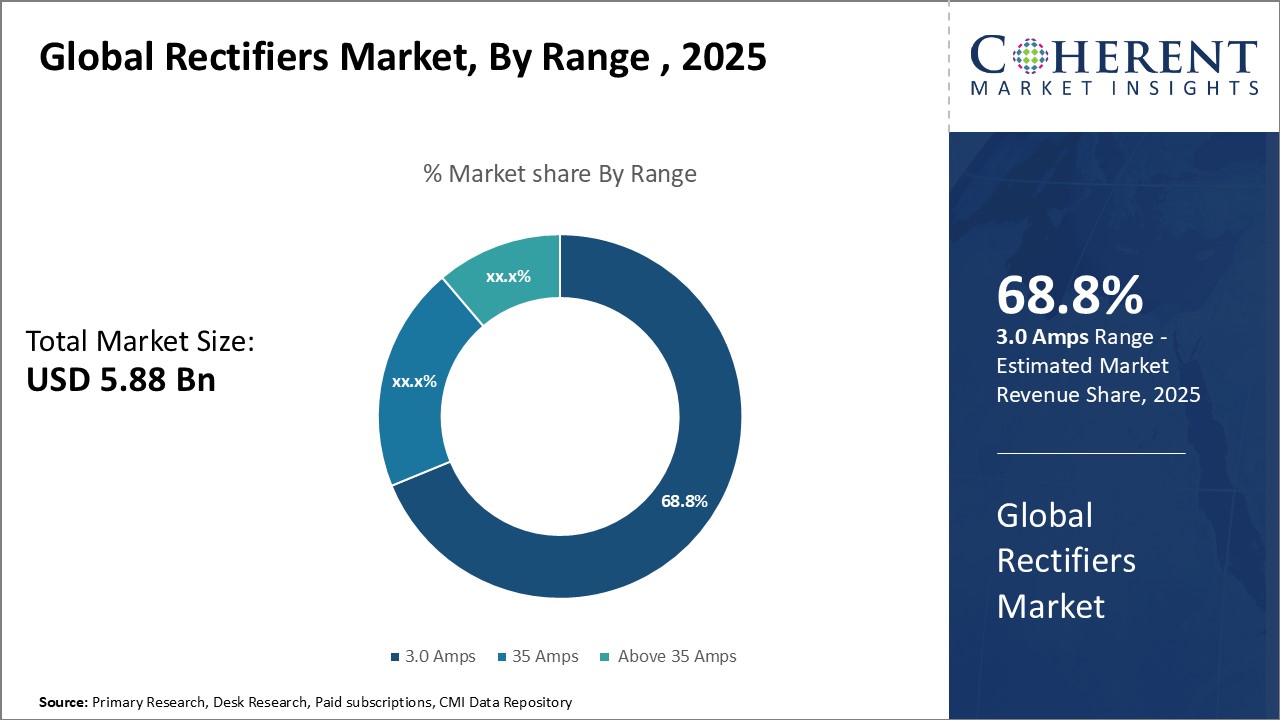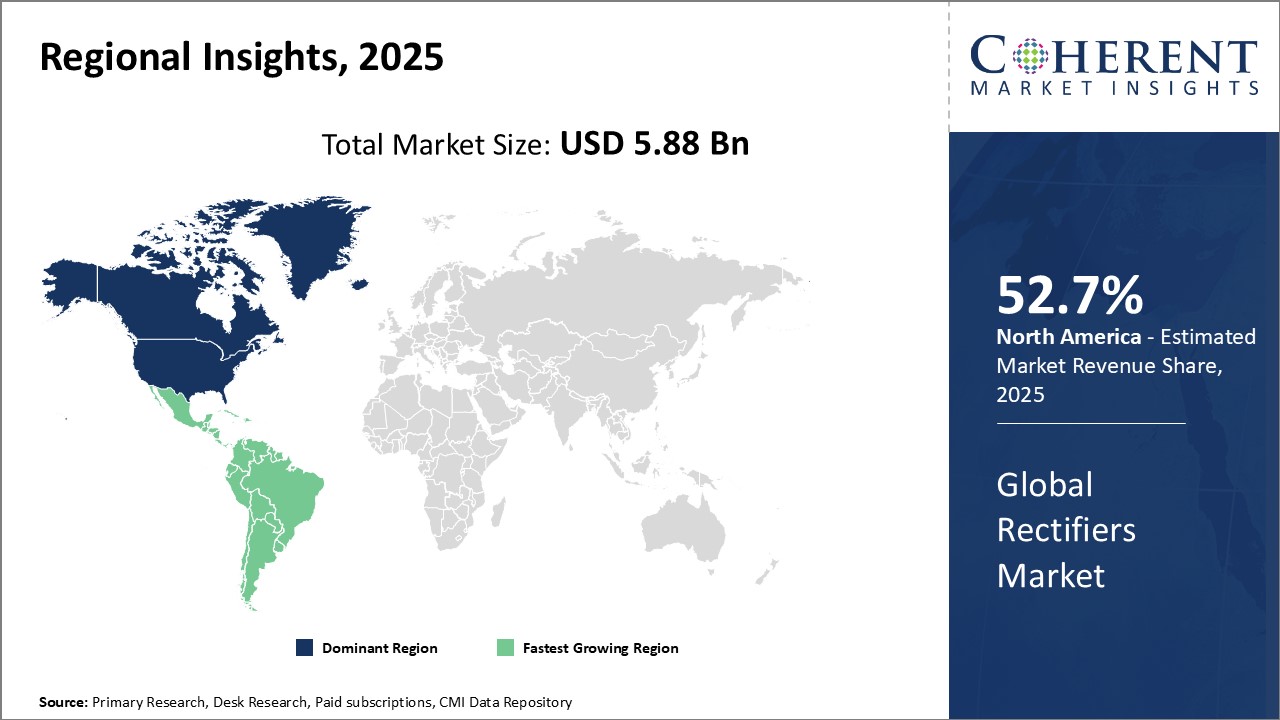Global Rectifiers Market Size and Trends
The rectifiers market is estimated to be valued at US$ 5.88 billion in 2025 and is expected to reach US$ 12.22 billion by 2032, growing at a compound annual growth rate (CAGR) of 11.0% from 2025 to 2032.

Discover market dynamics shaping the industry: Download Free Sample
The rectifiers market is expected to witness significant growth during the forecast period. An increasing demand for diode rectifiers from various industries like electronics, automotive, manufacturing, and telecommunication is positively influencing the market growth. Diode rectifiers are increasingly being used in power supplies, battery chargers, and various other applications due to advantages like high efficiency and low cost. Moreover, rapid industrialization and urbanization in developing regions is creating new growth avenues for rectifier manufacturers. However, the emergence of alternatives like switching voltage regulators and planned obsolescence of existing rectifier products may hamper the market expansion to some extent in the coming years.
Market Concentration and Competitive Landscape

Get actionable strategies to beat competition: Download Free Sample
Rising Demand from Power ElectronicsThe increasing dependency of various industries on power electronics is a key factor driving growth in the rectifiers market. Power electronics have become essential across several sectors such as industrial, automotive, consumer electronics, healthcare, aviation, and others. Almost every product today uses some form of power electronic components and circuitry to convert electric power efficiently. For example, industrial applications utilize power electronics for motor drives, variable speed control, power supplies, welding equipment, and several other machinery. Similarly, the growing penetration of electronics in vehicles is surging the demand for automotive power modules and battery charging systems.
On the consumer front, the proliferation of smart devices and home appliances is propelling the need for efficient power management Integrated circuits (ICs), adapters, and chargers. Even industries like healthcare now broadly employ power electronics in complex medical equipment like Magnetic Resonance Imaging (MRI) machines, ultrasound, ventilators, and others. Furthermore, sectors like renewable energy and aviation are increasingly transitioning towards advanced power conversion systems. All these diverse end-use domains require reliable rectification of AC voltages to regulated DC forms suitable for their operation. Effective rectification performed by suitable rectifier circuits plays a pivotal role in powering today's technologies seamlessly.
Whether it be small switching-mode power supplies or heavy-duty phase-controlled converters, rectifiers have become an indispensable component of power electronic systems. Their ability to rectify power cleanly and precisely as per the load's varying voltage-current needs is paramount. Owing to the skyrocketing reliance of core industries and daily-use products on power electronics, the demand for high-performance rectifiers is projected to surge significantly in the coming years. Semiconductor rectifiers and diode bridges that are able to rectify high currents efficiently will be highly sought after across the manufacturing sector.
Increased Adoption of Renewable Energy Sources
The global push towards adopting carbon-neutral renewable energy sources is another key aspect driving the growth of rectifiers market. Governments and organizations worldwide are aggressively promoting the generation of electricity through solar, wind, hydro, and other clean energy solutions. These renewable power plants extensively employ power electronic converters to transfer the variable voltage generated to transmission networks or load centers. Central to the operation of such power conversion systems are robust rectification circuits that can continuously convert the AC output of renewable sources into regulated DC forms.
Effective rectification plays a pivotal role in extracting maximum power from intermittent energy sources like solar PV arrays.

To learn more about this report, Download Free Sample
Market Challenges: High R&D CostThe rectifiers market faces several challenges. Manufacturers face rising competition from alternative technologies that perform similar functions. Falling prices of components used in rectifiers is putting pressure on margins. Strict environmental regulations around the globe mandate the use of less polluting materials, thus increasing the production costs. Declining demand from developed markets as they reach saturation also poses a threat. Younger consumers prefer newer technologies, reducing the appetite for traditional rectifiers.
Market Opportunities: Rapid Industrialization In Emerging Economies
However, the market also presents multiple opportunities. Rapid industrialization and infrastructure growth in developing economies is fueling demand for rectifiers. Sectors like rail, telecom, and new energy are investing heavily, needing efficient power solutions. Efforts are on to develop thinner, lighter, and more powerful rectifiers to leverage nanotechnology and materials science. Integration of newer materials opens up avenues for enhanced performance and additional functionalities.
Insights By Product Type- Ease of Installation Drives the Growth of Single-Phase Rectifiers
Within the product type segment of the rectifiers market, single phase rectifiers contribute the highest share of 68.8% in 2025 due to their ease of installation and use. As the name suggests, single phase rectifiers only require a single phase power source to function compared to three phase rectifiers which need a three phase power supply. This makes single phase rectifiers much simpler to install as they can utilize standard household wiring and plug directly into a standard wall outlet. Their single phase power requirement also means they do not need complex circuitry or additional components like transformers that three phase rectifiers require.
The simplicity of single phase rectifiers translates directly into lower installation and wiring costs. Contractors and installers can implement single phase rectifier systems much faster with less hassle compared to three phase versions. This ease of installation is a major driver of demand in applications like residential solar systems, small industrial machinery, laptop chargers and other consumer electronics where quick setup is prioritized over higher power capacity. Manufacturers also find single phase rectifiers easier to produce since their internal circuit design is less complicated than three phase varieties. This improves production efficiency and helps keep costs down, further boosting the attractiveness of single phase rectifiers.
The mass consumer market is another area driving robust demand. Billions of small household appliances like LED lights, fans, and air conditioners use single phase rectifiers inside due to their low cost and plug-and-play functionality. As the global middle class expands and disposable incomes rise particularly in developing nations, sales of such small appliances are growing rapidly. This translates to increased volume opportunities for low cost single phase rectifiers catering to the mass market. Overall, the unparalleled ease of installation along with applications in residential, small industrial and mass consumer sectors makes single phase the top choice within the product type segment.

To learn more about this report, Download Free Sample
Insights By Range- Wide Applications Fuel the Growth of 3.0 Amp RectifiersWithin the range segment of the rectifiers market, 3.0 amp rectifiers command the highest share of 57.7% in 2024 due to their suitability for a vast array of applications that require moderate power loads. As electronics and other electrical equipment have become more efficient, 3.0 amp rectifiers are able to adequately handle the power needs of many systems. A rating of 3.0 amps strikes an ideal balance between capabilities and costs. They are powerful enough for small motors, lights and chargers but produce less heat and use cheaper components compared to higher amperage rectifiers.
Laptops and mobile phones are two of the largest application areas for 3.0 amp rectifiers globally. Billions of these consumer devices need low power rectifiers for charging and internal circuitry, keeping demand for affordable 3.0 amp units very robust. Other booming sectors like LED lighting also employ 3.0 amp rectifiers extensively. Their efficiency at converting AC to DC makes LED drivers an ideal application that can benefit from the moderate yet sufficient power delivery of a 3.0 amp rating. Agricultural applications involving low power water pumps, battery chargers and small appliances also opt for 3.0 amp rectifiers due to their cost-effectiveness.
Additionally, industries involved in small electric motors rely heavily on 3.0 amp rectifiers. Numerous machines from washing machines to power tools contain small brushed motors powered by standardized 3.0 amp rectifier units. The widespread prevalence of these applications across various sectors translates to huge and stable volumes for 3.0 amp rectifiers compared to other ratings. It is this unmatched spread of suitable usage scenarios that establishes 3.0 amp rectifiers as the dominant range segment within the broader rectifiers market.
Insights By Industry Vertical - Rising Consumer Electronics Drive Growth in Rectifier Demand
The consumer electronics industry is a key driver of growth within the industry vertical segment with 35.2% market share in 2025 of the rectifiers market. As disposable incomes globally rise alongside relentless consumer demand for new technologies, the consumer electronics sector continues to rapidly expand. Every new release of laptops, TVs, smartphones, and other devices relies on embedded rectifiers for power management functions, leading to a direct correlation between consumer electronics industry growth and rectifier demand.
Sophisticated consumer devices like flagship smartphones and 4K TVs pack increasingly advanced chips, sensors and connectivity features that place additional power demands. Cutting-edge technologies such as flexible screens, Artificial Intelligence (AI) processors, and fast charging also spurs innovations in compact, high-efficiency rectifier designs suited for slim and power-packed electronics. Meanwhile, the proliferation of smart home appliances, wearables and augmented reality tools creates countless new opportunities for rectifiers across the evolving consumer landscape. Rectifier suppliers are continually challenged to keep pace with innovation in consumer tech, driving ongoing R&D efforts to develop new generations of optimized rectifier solutions.
Massive manufacturing and sales volumes within the consumer electronics sector translate to huge procurement needs from manufacturers worldwide. Prominent industry players spend multibillion-dollar amounts annually on purchasing various rectifier products. This concentration of significant market influence gives the consumer electronics vertical unmatched purchasing power and spends compared to other industry segments like automotive or industrial. Such dominance of the consumer electronics space positions it as the leader among industry verticals driving the global rectifier market growth. Quick improvements and increasing purchases by the growing middle class solidify consumer technology's position as a key driver of growth for the foreseeable future.
Regional Insights

Need a Different Region or Segment? Download Free Sample
North America has established itself as the dominant region with 52.7% market share in 2025 in the global rectifiers market. The presence of major players in the region such as Analog Devices, ON Semiconductor, and STMicroelectronics has contributed significantly to its leadership position. These companies have large production facilities and R&D centers focused on innovating rectifier technologies. They also actively collaborate with various industries employing rectifiers to cater to their unique requirements. As a result, North America witnesses the earliest adoption of new rectifier products.
Further, the region's advanced industrial infrastructure and mature end-use markets have created a robust demand for rectifiers. Industries, such as automotive, consumer electronics, and telecommunications, massively utilize rectifiers in their applications and consider North American companies as the primary suppliers. The free trade policies have also made North America an important manufacturing and export hub for rectifiers. Its proximity to Latin American markets enables North American players to address regional demands efficiently.
On the other hand, the Asia Pacific region has emerged as the fastest growing market for rectifiers. Countries like China, India, South Korea, and Taiwan are spearheading this growth on account of rapid industrialization and infrastructure development. In particular, the growth of Small and Medium Enterprises (SMEs) engaged in industrial automation and renewable energy projects has opened promising opportunities. These SMEs are actively procuring rectifiers to support their expansion. Additionally, the regional governments are introducing supportive policies and incentives to boost the domestic manufacturing of industrial equipment and electronic goods. This is prompting international rectifier companies to increase their presence in Asia Pacific via organic and inorganic routes to target such emerging opportunities. As a result, the region is expected to surpass other major markets over the coming years.
Market Report Scope
Global Rectifiers Market Report Coverage
| Report Coverage | Details | ||
|---|---|---|---|
| Base Year: | 2024 | Market Size in 2025: | USD 5.88 Bn |
| Historical Data for: | 2020 To 2024 | Forecast Period: | 2025 To 2032 |
| Forecast Period 2025 to 2032 CAGR: | 11.0% | 2032 Value Projection: | USD 12.22 Bn |
| Geographies covered: |
|
||
| Segments covered: |
|
||
| Companies covered: |
ON Semiconductor, Vishay Intertechnology, Inc., Infineon Technologies AG, STMicroelectronics, Fuses Unlimited Inc., Toshiba Corporation, Diodes Incorporated, NXP Semiconductors, Renesas Electronics Corporation, and Mitsubishi Electric Corporation |
||
| Growth Drivers: |
|
||
| Restraints & Challenges: |
|
||
Uncover macros and micros vetted on 75+ parameters: Get instant access to report
Global Rectifiers Industry News
- In April 2022, Diodes Incorporated is a global semiconductor company that designs, manufactures, and supplies analog semiconductor products. introduced a new series of small-sized high-efficiency rectifiers called CSPs. These include the DIODES SDM5U45EP3, DIODESTM SDM4A40EP3, and DIODES SDT4U40EP3, which boast the highest current densities in their category. These products cater to the growing demand for compact and powerful electronic systems.
- In April 2022, Diodes Incorporated is a global semiconductor company that designs, manufactures, and supplies analog semiconductor products. launched DIODES APR34910, a low secondary-side synchronous rectifier switch designed for power adapters used in set-top boxes, laptops, and mobile phones. With its low 10m RDS (ON) and 100V N channel MOSFET, APR34910 minimizes power losses and enhances efficiency, providing a high-performance solution for users.
- In January 2022, Comchip Technology Co. Ltd. is a semiconductor company based in Taiwan that specializes in the design, manufacturing, and distribution of diodes and other semiconductor components. introduced a range of rectifiers from HBS502-HF to HBS510-HF. These rectifiers are designed with features such as surface mount bridges, compact packaging, glass passivation in chip junctions, and the ability to handle high forward and surge currents.
- In December 2021, Guangxi Liuzhou Special Transformer Company Limited is a company based in Liuzhou, Guangxi, China, specializing in the manufacturing and distribution of special transformers. supplied a rectifier transformer for an Italian graphite electrode project. This transformer was part of a complete rectification solution that included a rectifier cabinet, high-voltage cabinet, high-current rectifier transformer with large capacity, and other necessary components.
*Definition: The rectifiers market consists of companies that manufacture and supply various types of rectifiers globally. Rectifiers are electrical components that convert alternating current (AC), which periodically reverses direction and changes magnitude continuously with time, into direct current (DC), which flows only in one direction. Major product types include diode rectifiers, transistor rectifiers, and thyristor rectifiers. The rectifiers find applications in varied industries like consumer electronics, automotive, telecommunication, healthcare, and others.
Market Segmentation
- Range Insights (Revenue, US$ BN, 2020 - 2032)
- 3.0 Amps
- 35 Amps
- Above 35 Amps
- Product Type Insights (Revenue, US$ BN, 2020 - 2032)
- Single Phase
- Three Phase
- Industry Vertical Insights (Revenue, US$ BN, 2020 - 2032)
- Automotive
- Consumer Electronics
- Power and Utility
- IT and Telecom
- Others
- Regional Insights (Revenue, US$ BN, 2020 - 2032)
- North America
- U.S.
- Canada
- Latin America
- Brazil
- Argentina
- Mexico
- Rest of Latin America
- Europe
- Germany
- U.K.
- France
- Italy
- Russia
- Rest of Europe
- Asia Pacific
- China
- India
- Japan
- Australia
- South Korea
- ASEAN
- Rest of Asia Pacific
- Middle East & Africa
- GCC Countries
- South Africa
- Rest of Middle East
- North America
- Key Players Insights
- ON Semiconductor
- Vishay Intertechnology, Inc.
- Infineon Technologies AG
- STMicroelectronics
- Fuses Unlimited Inc.
- Toshiba Corporation
- Diodes Incorporated
- NXP Semiconductors
- Renesas Electronics Corporation
- Mitsubishi Electric Corporation
Share
Share
About Author
As an accomplished Senior Consultant with 7+ years of experience, Pooja Tayade has a proven track record in devising and implementing data and strategy consulting across various industries. She specializes in market research, competitive analysis, primary insights, and market estimation. She excels in strategic advisory, delivering data-driven insights to help clients navigate market complexities, optimize entry strategies, and achieve sustainable growth.
Missing comfort of reading report in your local language? Find your preferred language :
Transform your Strategy with Exclusive Trending Reports :
Frequently Asked Questions
EXISTING CLIENTELE
Joining thousands of companies around the world committed to making the Excellent Business Solutions.
View All Our Clients
